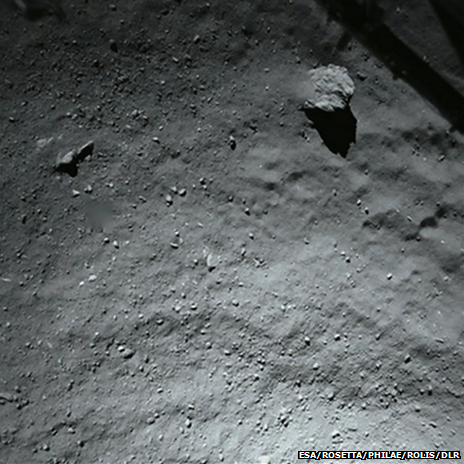Rosetta: concerns for robot probe Philae after uneven landing on comet
After a historic but awkward comet landing, the robot probe Philae is now stable and sending pictures - but there are concerns about its battery life.
After two bounces, the first one about 1km back out into space, the lander settled in the shadow of a cliff, 1km from its intended target site.
It may now be problematic to get enough sunlight to charge its battery systems.
Launched in 2004, the European Space Agency (ESA) mission hopes to learn about the origins of our Solar System.
It has already sent back the first images ever taken from the crumbling, fractured terrain of a comet.
Philae got to the icy 67P/Churyumov-Gerasimenko on the back of Esa's Rosetta satellite after a 10-year, 6.4 billion-km (4bn-mile) journey, which reached its climax on Wednesday with a seven-hour drop to the surface.
After showing an image that indicates Philae's presumed location - on the far side of a large crater that was earlier considered but then rejected as a landing site - the head of the lander team, Dr Stephan Ulamec, said: "We could be somewhere in the rim of this crater, which could explain this bizarre... orientation that you have seen."
Pictures taken by Philae of its surroundings show it pressed up against what appears to be a hard wall of some kind.
Telemetry indicates it is on a slope or perhaps even on its side.
Certainly, one of its three feet is not in contact with the surface.
The key issue vexing controllers right now is the lighting conditions.
Philae is receiving about 1.5 hours of illumination during every 12-hour rotation of the comet.
This will be insufficient to top up its battery system once the primary charge it had on leaving Rosetta runs out. That was some 60-plus hours.
It means Philae is unlikely to be operating in its present state beyond Saturday.
One remarkable image taken by the "mothership" Rosetta shows Philae as a tiny speck, headed for history
Engineers are examining how they might re-orientate the robot to maximize the light reaching its solar panels.
More extreme options being considered even include using some of the moving parts on the lander to try to make a hopping motion that would carry it clear of the shadows.
But, in truth, there is probably insufficient time to plan and then execute such a strategy.
The priority right now is to use Philae to acquire as much information as possible about the comet.
In this regard, researchers are thrilled by the performance of the probe.
However, they would dearly love to use the lander's drill. This was one of the key objectives of the mission - to pull up sub-surface material for chemical analysis in onboard labs.
But the team currently cannot contemplate such an operation with the probe so delicately positioned on only two feet. The drill's rotational forces could destabilize Philae.
Controllers will see what they can do to lower the third foot to the surface.
If that is not possible, drilling may be commanded towards the end of the primary battery window. By then, scientists would have little to lose anyway.
"This is a very typical operational decision," explained Paolo Ferri, the head of Esa's operations. "You gather everything you can first, and then the risky things - you only do them at the end."
Pictures have been snapped on different sides of the lander, illustrated here with the images arrayed around it
Where did Philae actually touch down? Images taken by the OSIRIS camera on Rosetta show the area surrounding original target site (highlighted in red)
Whatever happens in the hours ahead, the mission is already assured of its place in history.
Its data - and that from Rosetta which continues to observe from overhead - will transform what we know about comets, and enable researchers to test several hypotheses about the formation of the Solar System and the origins of life.
One theory holds that comets were responsible for delivering water to the planets. Another idea is that they could have "seeded" the Earth with the chemistry needed to help kick-start biology.



0 reacties:
Post a Comment